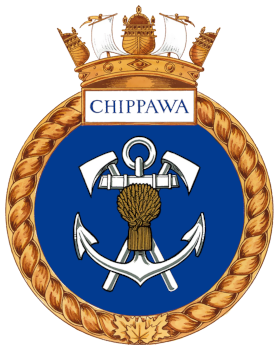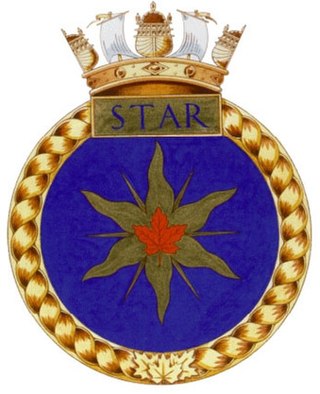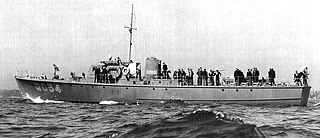
The Royal Canadian Navy is the naval force of Canada. The navy is one of three environmental commands within the Canadian Armed Forces. As of February 2024, the RCN operates 12 Halifax-class frigates, 12 Kingston-class coastal defence vessels, 4 Victoria-class submarines, 2 Harry DeWolf-class offshore patrol vessels, 8 Orca-class patrol vessels, and several auxiliary vessels. The RCN consists of 8,400 Regular Force and 4,100 Primary Reserve sailors, supported by 3,800 civilians. Vice-Admiral Angus Topshee is the commander of the Royal Canadian Navy and chief of the Naval Staff.
Several vessels of the Royal Navy have been named HMS Nonsuch, presumably named after Nonsuch Palace:

HMCS Edmonton is a Kingston-class coastal defence vessel that has served in the Canadian Forces since 1997. Edmonton is the fourth ship of its class, all of which were built for the Maritime Coastal Defence Vessel Project. The ship is the first vessel to use the designation HMCS Edmonton. The ship is assigned to Maritime Forces Pacific (MARPAC) and is homeported at CFB Esquimalt.

HMCS Carleton is a Canadian Forces Naval Reserve Division (NRD) located in Ottawa, Ontario, Canada. Dubbed a stone frigate, HMCS Carleton is a land-based naval training establishment crewed by part-time sailors and also serves as a local recruitment centre for the Canadian Forces Naval Reserve. It is one of 24 naval reserve divisions located in major cities across Canada.

HMCS York is a Royal Canadian Navy Reserve Division (NRD) located in Toronto, Ontario. Dubbed a stone frigate, HMCS York is a land-based naval establishment for part-time sailors as well as a local recruitment centre for the Canadian Naval Reserve.

HMCS Chippawa is a Royal Canadian Navy Reserve Division (NRD) located in Winnipeg, Manitoba. Dubbed a stone frigate, HMCS Chippawa is a land-based naval establishment for part-time sailors as well as a local recruitment centre for the Royal Canadian Navy (RCN).

The Coastal Forces of the Royal Canadian Navy (RCN) was a specialized naval force of well-armed, small and fast motor launch (ML) and motor torpedo boat (MTB) flotillas, primarily manned by members of the Royal Canadian Naval Volunteer Reserve (RCNVR). Tasked with escort, coastal defence, anti-submarine, minesweeping and search and rescue duties, the Coastal Forces of the RCN contributed to securing Allied sea lines of communication off the coasts of Canada and Britain during the Second World War.

HMCS Star is a Canadian Forces Naval Reserve Division (NRD) located in Hamilton, Ontario. Dubbed a stone frigate, HMCS Star is a land-based naval establishment for training part-time sailors as well as functioning as a local recruitment centre for the Royal Canadian Navy (RCN). The second oldest of 24 naval reserve divisions located in major cities across Canada, Star was stood up on 15 March 1923 as the Royal Canadian Naval Volunteer Reserve (RCNVR) Hamilton Half Company and then on 1 November 1941 as HMCS Star.

The Naval Reserve is the Primary Reserve component of the Royal Canadian Navy (RCN). The primary mission of the NAVRES is to force generate sailors and teams for Canadian Armed Forces (CAF) operations, including: domestic safety operations as well as security and defence missions, while at the same time supporting the Navy's efforts in connecting with Canadians through the maintenance of a broad national presence.

HMCS Hunter is a Canadian Forces Naval Reserve Division (NRD) located in Windsor, Ontario. Dubbed a stone frigate, HMCS Hunter is a land-based naval training establishment crewed by part-time sailors and also serves as a local recruitment centre for the Canadian Forces Naval Reserve. It is one of 24 naval reserve divisions located in major cities across Canada.

HMCS Brunswicker is a Canadian Forces Naval Reserve Division (NRD) located in Saint John, New Brunswick. Dubbed a stone frigate, HMCS Brunswicker is a land-based naval training establishment crewed by part-time sailors and also serves as a local recruitment centre for the Canadian Forces Naval Reserve and the Royal Canadian Navy (RCN). It is one of 24 naval reserve divisions located in major cities across Canada.

HMCS Cabot is a Canadian Forces Naval Reserve Division (NRD) located in St. John's, Newfoundland and Labrador. Dubbed a stone frigate, HMCS Cabot is a land-based naval training establishment crewed by part-time sailors and also serves as a local recruitment centre for the Canadian Forces Naval Reserve. It is one of 24 naval reserve divisions located in major cities across Canada.
HMCS Cataraqui is a Canadian Forces Naval Reserve Division (NRD) located in Kingston, Ontario. Dubbed a stone frigate, HMCS Cataraqui is a land-based naval establishment for part-time sailors as well as a local recruitment centre for the Royal Canadian Navy (RCN). It is one of 24 naval reserve divisions located in major cities across Canada.
HMCS Radisson is a Canadian Forces Naval Reserve Division (NRD) located on Île Saint-Christophe in Trois-Rivières, Quebec. Dubbed a stone frigate, HMCS Radisson is a land-based naval training establishment crewed by part-time sailors and also serves as a local recruitment centre for the Canadian Forces Naval Reserve. It is one of 24 naval reserve divisions located in major cities across Canada.
Canadian Forces Auxiliary Vessel (CFAV) Lynx was one of ten wooden YAG-300 vessels built for the Royal Canadian Navy (RCN) between 1953 and 1955. Built for use as auxiliary craft, Lynx primarily served as an at-sea training platform for junior naval officers, boatswains, reserve personnel and Sea Cadets at Canadian Forces Base (CFB) Esquimalt.

Canadian Forces Auxiliary Vessel (CFAV) Grizzly was one of ten wooden YAG 300 vessels built for the Royal Canadian Navy (RCN) between 1953 and 1955. Built for use as auxiliary craft, Grizzly primarily served as an at-sea training platform for junior naval officers, boatswains, reserve personnel and Sea Cadets at Canadian Forces Base (CFB) Esquimalt. Her name perpetuated the WWII armed yacht HMCS Grizzly was reused for PTC 60 GrizzlyOrca-class Patrol Craft Training (PCT) tender that replaced the YAG 300 vessels as the RCN training tenders in 2008.

HMC MLQ052 was a wooden Fairmile B Motor Launch (ML) upgunned submarine chaser delivered to the Royal Canadian Navy (RCN) on 31 October 1941. Originally designed for the Royal Navy by W.J. Holt of the British Admiralty and built by British boatbuilder Fairmile Marine, during the Second World War eighty Fairmile B motor launches were built in Canada for service with the Coastal Forces of the RCN.
Canadian Forces Auxiliary Vessel (CFAV) Otter was one of ten wooden YAG-300 vessels built for the Royal Canadian Navy (RCN) between 1953 and 1955. Built for use as auxiliary craft, Otter primarily served as an at-sea training platform for junior naval officers, boatswains, reserve personnel and Sea Cadets at Canadian Forces Base (CFB) Esquimalt.

HMC ML Q054 was a wooden Canadian-built Fairmile B Motor Launch (ML) upgunned submarine chaser delivered to the Royal Canadian Navy (RCN) on 17 October 1941. Originally designed for the Royal Navy by W.J. Holt of the British Admiralty and built by British boatbuilder Fairmile Marine, during the Second World War eighty Fairmile B motor launches were built in Canada for service with the Coastal Forces of the RCN.















